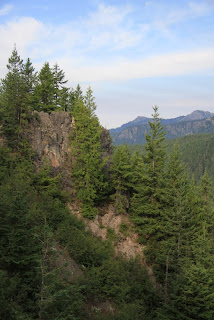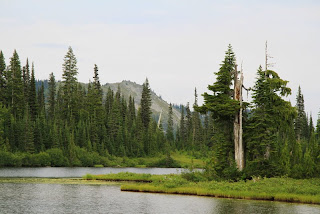On our way to eastern Washington in August, we decided to spend a day and possibly a second day in Mount Rainier National Park. It turned out that we a day and over night at the end of the first day, but went on because the weather had changed and was very poor.
We left early in the morning and came into the park from the southwest at Nisqually entrance. and made our first stop at Kautz Creek, not far inside the entrance. It was still nearly dark, however, and my wife who had been sleeping did not even get out for pictures.
The second stop was at Longmire where again my wife stayed sleeping while I wandered a part of the Trail of the Shadows and the meadows across from the visitors' center and watched the beginning of the sunrise over Rainier and over the hots springs there.
There were few wildflowers blooming but near the meadows near Longmire I found a number of Hooded Ladies'-tresses, Spiranthes romanzoffiana, at the peak of their bloom. We would later see and photograph lots more of them, but not knowing that I spent quite a bit of time there.
Next stop was at a turn-off near the Nisqually River. We hiked the short distance to the river and the log bridge that spans it (the Wonderland Trail crosses the river there). My wife was now awake and the sun was up and so she joined the fun taking as many or more pictures as myself.
Further up we made a brief stop at Christine Falls, very beautiful but difficult to photograph because the falls are in a narrow canyon very close to the road. We also took photos there of an area where water was dripping down the cliff face next to the road.
Not far from Christine Falls we took a one-way side road that gave us wonderful view of the Tatoosh Range with the Paradise River far below and Mount Rainier, almost always visible, looming over everything. I was
here, too, that we began to see a few wildflowers.
Narada Falls was the next stop. The small parking area gives some views of the falls but one is looking nearly straight down onto the top of the lower falls and so we hiked a short trail to a viewpoint across the narrow canyon into which the falls drop. These falls, too are on the Paradise River.
Near the falls we found our first Mountain Bog Gentians (Gentiana calycosa) as well as another orchid, the Slender Bog Orchis, Platanthera stricta, and the Cascade Aster (Aster ledophyllus). Even though we had gained considerable elevation the wildflowers were still quite sparse.
That changed when we reached Paradise, the highest point on the west side road. We made several stops along the way at different viewpoints for pictures of Mount Rainier and the Nisqually Glacier where the river of the same name has its source.
We spent the rest of the morning and most of the afternoon at Paradise, wandering the area of the visitor's center where we found many more Mountain Bog Gentians and Hooded Ladies'-tresses all at the peak of their bloom season, though very late in the summer.
Other wildflowers found in the area were Ranunculus, Polygonum, Indian Paintbrush, Valerian, Purple Monkeyflowers, Asters, Pearly Everlasting and Lupine. The area is like a huge flower garden at this time of the year and we thoroughly enjoyed all the flwoers.
After making ourselves lunch we headed up the Nisqually Vista trail taking pictures of the wildflowers and meadows along the way. We were also able to get pictures of a Mountain Fritiallary butterfly, a bit tattered but still beautiful and very active in the sunshine.
The views of Mount Rainier and the Nisqually Glacier from the end of the trail were magnificent, and though not visible in the pictures we took, a line of climbers heading for the base camp prior to their ascent of the mountain was also just visible, especially with binoculars.
Finished with that trail and back at the visitor's center we hiked the Skyline Trail to Myrtle Falls and then wandered some of the other trails in the area. The day was getting on, however, and there were several more places to visit that day, so we headed further east through Steven's Canyon.
We made brief stops at Reflection Lakes and at Sunbeam Creek but at the lakes the light was wrong and the weather was changing so our pictures were not very good. Box Canyon, a very narrow canyon, thorough which runs the Muddy Fork Cowlitz River, was also one of our stops.
Our final stop was at the Grove of the Patriarchs, an island grove of massive old Western Red Cedars, Western Hemlocks and Douglas Firs, some reputed to be over a thousand years old. The light was bad, however, and the pictures less than satisfactory, though I've included a few.
We found a turnoff where there were a few tables and while eating our evening meal we watched the sunset over Mount Rainier, a spectacular end to a wonderful day. Nearly dark we found a place to spend the night before proceeding out the south east entrance and on our way.


























































































































































6 comments:
Beautiful area! You came away with some really pretty shots =)
Rainier is such a beautiful park. I could spend the rest of my life there and not see all I wanted to see. Thanks for commenting, Fizzie.
I think that's true of so many of the beautiful, wild places on this planet... We can only hope to take them all in and appreciate them in their entirety before our human activities or ignorance destroy them.
Saw a post by a friend today who had been to the Florida Keys for the first time in many years and found them an underwater desert where they had once been alive with fish and coral. Sad.
I've gone back to some dive sites that I visited 10 yrs. ago and found them unrecognizable. Once vibrant coral reefs teeming with life were virtually nonexistent or the apex predators were all gone (which spells nothing but bad things for the health of the reef in the future). Used to see 2-3 species of sharks in abundance in these places and now they're all gone & the reefs are definitely dying.
I can attest to the fact that the FL Keys are just a shell of their former glory -- even in protected areas -- both above & below water.
Pretty sad... And no place on the planet is safe for wild things anymore. Yet, humans, in their ignorance, seek to control populations of wild animals instead of controlling their own numbers which are the real scourge on the planet.
It's always sad when you find that some idiots have destroyed something rare and irreplaceable, especially in the natural world.
Post a Comment